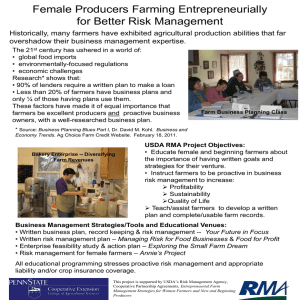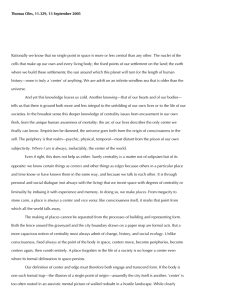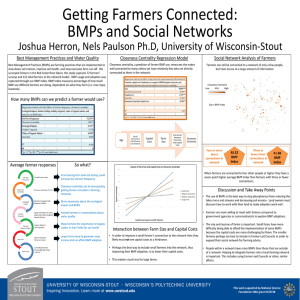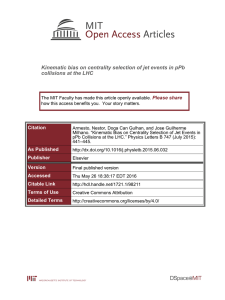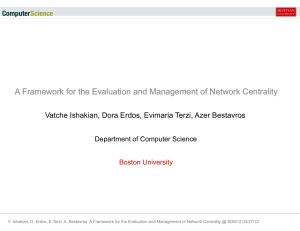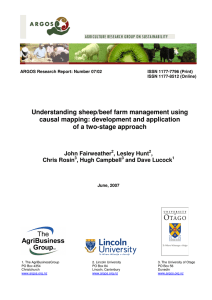The Social Network to Improve Water Quality in the Red
advertisement
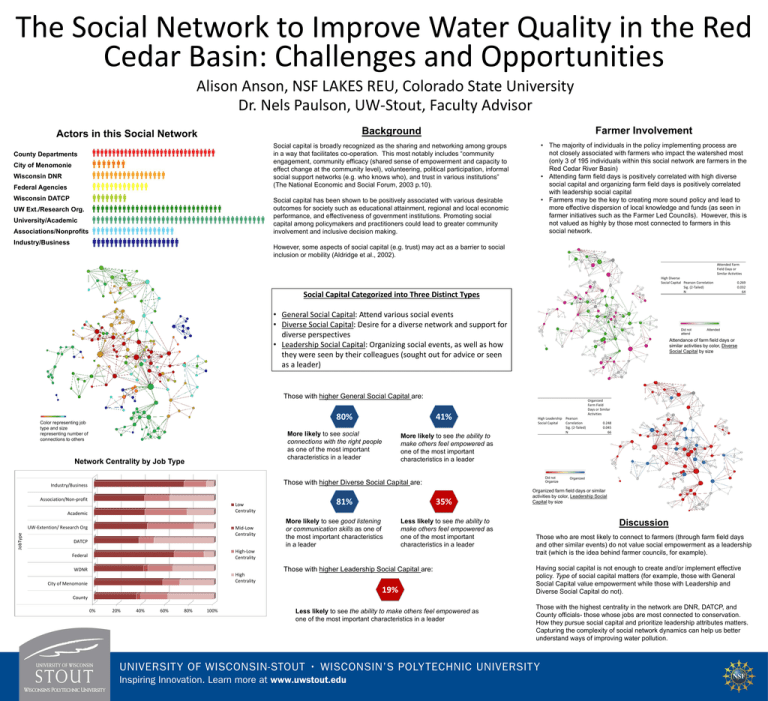
The Social Network to Improve Water Quality in the Red Cedar Basin: Challenges and Opportunities Alison Anson, NSF LAKES REU, Colorado State University Dr. Nels Paulson, UW-Stout, Faculty Advisor Background Farmer Involvement Social capital is broadly recognized as the sharing and networking among groups in a way that facilitates co-operation. This most notably includes “community engagement, community efficacy (shared sense of empowerment and capacity to effect change at the community level), volunteering, political participation, informal social support networks (e.g. who knows who), and trust in various institutions” (The National Economic and Social Forum, 2003 p.10). • The majority of individuals in the policy implementing process are not closely associated with farmers who impact the watershed most (only 3 of 195 individuals within this social network are farmers in the Red Cedar River Basin) • Attending farm field days is positively correlated with high diverse social capital and organizing farm field days is positively correlated with leadership social capital • Farmers may be the key to creating more sound policy and lead to more effective dispersion of local knowledge and funds (as seen in farmer initiatives such as the Farmer Led Councils). However, this is not valued as highly by those most connected to farmers in this social network. Actors in this Social Network County Departments City of Menomonie Wisconsin DNR Federal Agencies Wisconsin DATCP Social capital has been shown to be positively associated with various desirable outcomes for society such as educational attainment, regional and local economic performance, and effectiveness of government institutions. Promoting social capital among policymakers and practitioners could lead to greater community involvement and inclusive decision making. UW Ext./Research Org. University/Academic Associations/Nonprofits Industry/Business However, some aspects of social capital (e.g. trust) may act as a barrier to social inclusion or mobility (Aldridge et al., 2002). Attended Farm Field Days or Similar Activities High Diverse Social Capital Pearson Correlation Sig. (2-Tailed) N Social Capital Categorized into Three Distinct Types • General Social Capital: Attend various social events • Diverse Social Capital: Desire for a diverse network and support for diverse perspectives • Leadership Social Capital: Organizing social events, as well as how they were seen by their colleagues (sought out for advice or seen as a leader) Did not attend Color representing job type and size representing number of connections to others More likely to see social connections with the right people as one of the most important characteristics in a leader Network Centrality by Job Type More likely to see the ability to make others feel empowered as one of the most important characteristics in a leader Association/Non-profit Low Centrality Academic UW-Extention/ Research Org Mid-Low Centrality DATCP 81% 35% More likely to see good listening or communication skills as one of the most important characteristics in a leader Less likely to see the ability to make others feel empowered as one of the most important characteristics in a leader High-Low Centrality Federal WDNR High Centrality City of Menomonie Those with higher Leadership Social Capital are: 19% County 0% 20% 40% 60% 80% 100% Organized Farm Field Days or Similar Activities High Leadership Pearson Social Capital Correlation Sig. (2-Tailed) N Did not Organize Those with higher Diverse Social Capital are: Industry/Business JobType 41% Less likely to see the ability to make others feel empowered as one of the most important characteristics in a leader Attended Attendance of farm field days or similar activities by color, Diverse Social Capital by size Those with higher General Social Capital are: 80% 0.269 0.032 64 0.248 0.045 66 Organized Organized farm field days or similar activities by color, Leadership Social Capital by size Discussion Those who are most likely to connect to farmers (through farm field days and other similar events) do not value social empowerment as a leadership trait (which is the idea behind farmer councils, for example). Having social capital is not enough to create and/or implement effective policy. Type of social capital matters (for example, those with General Social Capital value empowerment while those with Leadership and Diverse Social Capital do not). Those with the highest centrality in the network are DNR, DATCP, and County officials- those whose jobs are most connected to conservation. How they pursue social capital and prioritize leadership attributes matters. Capturing the complexity of social network dynamics can help us better understand ways of improving water pollution.




